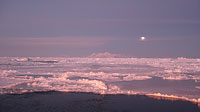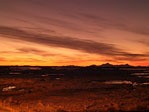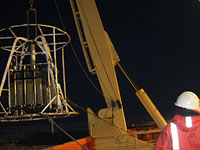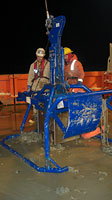

 | |||||||||||||||||||
|
|
Journals 2008/2009Roy Arezzo
July 15, 2008 Yesterday I reported on my first Antarctic sunset. Skies have remained clear and we have had fantastic weather, albeit cold. When most folks hear about my summer voyage to Antarctica's winter, they cringe. The secret is that on a clear day, the four hours of daylight is some of the best light observed from Earth. The colors are difficult to describe but imagine the best sunset and sunrise you have ever seen; now picture the sky flowing between all the sunset colors for four hours straight. Since I am on the day shift, I was able to watch sun sort of rise and set between meals. To top it off we are only a few days from the full moon, which never sets, so there are no bad views out there. The peaks of ice are drenched in mauve tones for hours around sunrise. As the sun goes down, the sky is ablaze with chrisom streaks setting the ice on fire with color.
It may sound like I stand around all day looking into the sky, taking photos, and looking up adjectives to describe them, but today being our first time on station, my 12 hour shift was filled with deck work, preserving samples and mud, lots of cold mud. Of course I could not wait to be on deck, so I was out by 9:30 a.m. in time to see us deploy our first megacore. It is difficult to photograph on watch since your wet hands tend to be wrestling some hand tool with gloves on - not ideal for documenting all the cool work around you. After my sunrise pictures I was able to catch the Megacore being deployed at the end of the night shift. It was so fun we did it twice on our watch. Megacore is not just a cool name; it is a coring device capable of extracting 12 separate, 10cm diameter by 60 cm core samples from the seafloor at a desired depth. The device is essentially a frame that holds a rack of trigger-controlled coring tubes mounted on a weighted slide. When the base of the frame hits bottom, the tension from the towline is reduced and the weighted slide drives the core tubes down into the sediment. When each core tube is pushed up into the lid by the pressure against the seabed, a spring loaded cover plate shuts under the tube to preserve the sample for the ride up. Once back on the ship each tube is logged in based on appearance and the height of the sediment is measured. Some samples are so pristine we find organisms grazing on top of the sediment or boring tunnels through the middle sections. The main problem has been keeping the mechanisms from freezing while out in the elements before deployment. We have taken to using a blow dryer to keep moving parts defrosted before we send it out into the sea.
Once the Megacore is on deck we all scurry to get the tubes inside but they need to be capped so no mud or water is lost before they are removed. Each core is then sliced to desired depth and prepared for various experiments. My job after removing the muddy core has been to preserve samples in formaldehyde to fix any organisms present to be used for biomass assays. The indoor lab work is fine after a few hours in the wet and cold but I do prefer working out on deck to the fume hood. When it comes to nutrients at the bottom we are mostly interested in the bioturbation level in the first ten centimeters of the seabed (the level where organisms feed and redistribute nutrients). However, beyond four inches there is plenty to learn, so we use other instruments to probe deeper into the seafloor. For a large volume of sediment we use a box core. The Box core can cut a huge sample (50 cm x 50 cm) since it is has a much larger metal chamber. More sampling area is useful for both biomass and biodiversity assessments.
The deepest sampling device we have onboard is the Kasten Core. The Kasten Core has less moving parts and is a simple weighted metal tube that is driven down into the bottom. It takes a deep narrow sample, which is important for measuring carbon burial rates over time. North Carolina State scientists remove pore water from between the grains of sediment at different layers from the core sample to test for the abundances of dissolved inorganic carbon and nutrients. The average sample holds information of the past 3000 to 4000 years. A full Kasten Core sample of 10 feet holds layers that can date back as far as 10,000 years, depending on the site. The last FOODBANCS study used Kasten Core samples to carbon-14 date the sediment and they found slower accumulation the further they went off shore. At station B, to the north of where we are now, the results showed that 30 centimeters of sediment accumulation represents about 1000 years of time.
The schedule of deployments of July 15, 2008 went as follows: CTD, Megacore, Yoyo Camera Test, Box Core, Kasten Core, Megacore, sleep. Now that the work has begun I would like to take this opportunity to thank The ARMADA Project for providing me the opportunity to be involved in this research. I would also like to express my deep gratitude to Craig Smith and Dave DeMaster for accepting me on this project, answering all my questions and editing my clumsy at-sea writing. |
||||||||||||||||||




